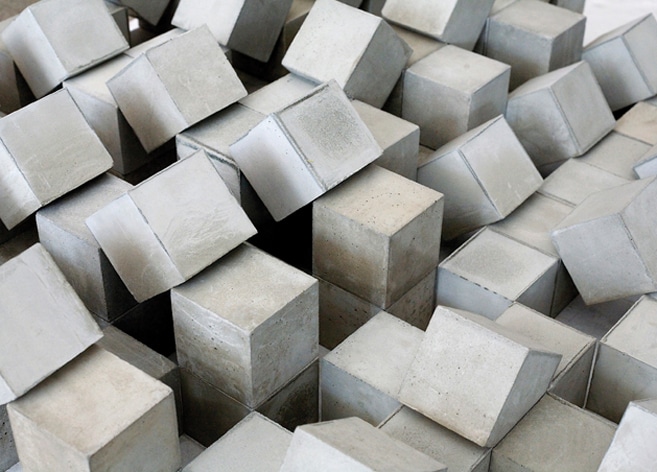Test for compressive strength is carried out either on cube or cylinder. Various standard codes recommends concrete cylinder or concrete cube as the standard specimen for the test. American Society for Testing Materials ASTM C39/C39M provides Standard Test Method for Compressive Strength of Cylindrical Concrete Specimens,
For cube test two types of specimens either cubes of 15 cm X 15 cm X 15 cm or 10cm X 10 cm x 10 cm depending upon the size of aggregate are used. For most of the works cubical moulds of size 15 cm x 15cm x 15 cm are commonly used.
This concrete is poured in the mould and tempered properly so as not to have any voids. After 24 hours these moulds are removed and test specimens are put in water for curing. The top surface of these specimen should be made even and smooth. This is done by putting cement paste and spreading smoothly on whole area of specimen.
These specimens are tested by compression testing machine after 7 days curing or 28 days curing. Load should be applied gradually at the rate of 140 kg/cm2 per minute till the Specimens fails. Load at the failure divided by area of specimen gives the compressive strength of concrete.

Following are the procedure for testing Compressive strength of Concrete Cubes
APPARATUS
Compression testing machine
PREPARATION OF CUBE SPECIMENS
The proportion and material for making these test specimens are from the same concrete used in the field.
SPECIMEN
6 cubes of 15 cm size Mix. M15 or above
MIXING
Mix the concrete either by hand or in a laboratory batch mixer
HAND MIXING
(i)Mix the cement and fine aggregate on a water tight none-absorbent platform until the mixture is thoroughly blended and is of uniform color
(ii)Add the coarse aggregate and mix with cement and fine aggregate until the coarse aggregate is uniformly distributed throughout the batch
(iii)Add water and mix it until the concrete appears to be homogeneous and of the desired consistency
SAMPLING
(i) Clean the mounds and apply oil
(ii) Fill the concrete in the molds in layers approximately 5cm thick
(iii) Compact each layer with not less than 35strokes per layer using a tamping rod (steel bar 16mm diameter and 60cm long, bullet pointed at lower end)
(iv) Level the top surface and smoothen it with a trowel
CURING
The test specimens are stored in moist air for 24hours and after this period the specimens are marked and removed from the molds and kept submerged in clear fresh water until taken out prior to test.
PRECAUTIONS
The water for curing should be tested every 7days and the temperature of water must be at 27+-2oC.
PROCEDURE
(I) Remove the specimen from water after specified curing time and wipe out excess water from the surface.
(II) Take the dimension of the specimen to the nearest 0.2m
(III) Clean the bearing surface of the testing machine
(IV) Place the specimen in the machine in such a manner that the load shall be applied to the opposite sides of the cube cast.
(V) Align the specimen centrally on the base plate of the machine.
(VI) Rotate the movable portion gently by hand so that it touches the top surface of the specimen.
(VII) Apply the load gradually without shock and continuously at the rate of 140kg/cm2/minute till the specimen fails
(VIII) Record the maximum load and note any unusual features in the type of failure.
NOTE
Minimum three specimens should be tested at each selected age. If strength of any specimen varies by more than 15 per cent of average strength, results of such specimen should be rejected. Average of there specimens gives the crushing strength of concrete. The strength requirements of concrete.
CALCULATIONS
Size of the cube =15cm x15cm x15cm
Area of the specimen (calculated from the mean size of the specimen )=225cm2
Characteristic compressive strength(f ck)at 7 days =
Expected maximum load =fck x area x f.s
Range to be selected is …………………..
Similar calculation should be done for 28 day compressive strength
Maximum load applied =……….tones = ………….N
Compressive strength = (Load in N/ Area in mm2)=……………N/mm2
=……………………….N/mm2
REPORT
a) Identification mark
b) Date of test
c) Age of specimen
d) Curing conditions, including date of manufacture of specimen
f) Appearance of fractured faces of concrete and the type of fracture if they are unusual
RESULT
Average compressive strength of the concrete cube = ………….N/ mm2 (at 7 days)
Average compressive strength of the concrete cube =………. N/mm2 (at 28 days)
Compressive strength of concrete at various ages:
The strength of concrete increases with age. Table shows the strength of concrete at different ages in comparison with the strength at 28 days after casting.
Age
|
Strength per cent
|
1 day
|
16%
|
3 days
|
40%
|
7 days
|
65%
|
14 days
|
90%
|
28 days
|
99%
|
Compressive strength of different grades of concrete at 7 and 28 days
Grade of Concrete
|
Minimum compressive strength N/mm2 at 7 days
|
Specified characteristic compressive strength (N/mm2) at 28 days
|
M15
|
10
|
15
|
M20
|
13.5
|
20
|
M25
|
17
|
25
|
M30
|
20
|
30
|
M35
|
23.5
|
35
|
M40
|
27
|
40
|
M45
|
30
|
45
|
No comments:
Post a Comment